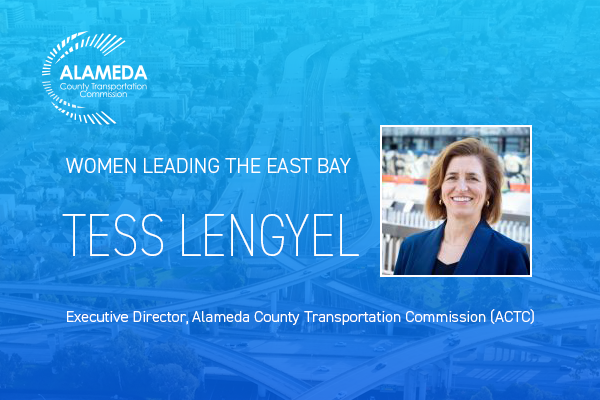In celebration of Women’s History Month in March and throughout the year, East Bay EDA will periodically highlight women leaders in the East Bay in our blog series “Women Leading the East Bay.” Take a moment to read some of our conversation with Tess Lengyel, Executive Director, Alameda County Transportation Agency (ACTC) about diversity and women leaders, with particular focus on the transportation sector.
Q. Why is celebrating Women’s History Month important to you, and what advice would you give to women who want to be leaders in predominantly male fields like transportation?
A. Women have had incredible impacts on history and society, and yet they have not had access to same opportunities and areas as men. The good news is that there are women in leadership positions in transportation, and when people see others like themselves, it opens opportunities for people to believe they could become that person. Thinking about my organization for a moment, we have three (3) deputy directors, two (2) of whom are women. And among our 22-member Commission, 15 of them are women. A majority of our current staff are female, and if you think about other Bay Area counties like Alameda, six (6) out of the nine (9) regional transportation agencies are led by women executives, the head of the Metropolitan Transportation Commission is also a woman, and the presidents two of our major transit operators in the East Bay – BART and AC Transit – are also women. For many women leaders, they understand the dynamics of the needs of women in transportation and what types of transportation they need in different phases of their lives.
LA Metro published a report on how women travel in 2019. More than half of their passengers are women, and many of them are some of their lowest income patrons. The report illuminated differences in how women travel, specifically on their transit system. For many women, being a caretaker makes up a large part of their lives – they have needs for grocery shopping, medical appointments, transporting children, and caring for elderly. Women bring an important perspective to the industry and it is really important as we look to planning, funding, and delivering transportation that the full range of community needs are understood, planned for and delivered.
Q. Which women leaders do you admire and why?
A. There are three people that I would like to highlight. Christine Munson was the first female executive director at the Alameda County Transportation Authority and she was my first female boss. She helped pass a sales tax measure in 2000 for which we just finished delivering the projects. She is an engineer and a great leader – she was really supportive of staff, focused on delivery, and made sure we knew what was happening with every single penny of taxpayers’ money – full accountability.
Mary King was on the Alameda County Board of Supervisors and served as an interim general manager for AC Transit. She was a key leader on some of the most complex and difficult efforts on marquis transportation projects, such as the first and second Measure B sales tax measures in Alameda County and selection of the design for the eastern span of the Bay Bridge.
Therese McMillan, Executive Director of ABAG/MTC is another woman who I have admired since I started my career. She forges strong partnerships, works across an array of stakeholders and is effective in getting things done. I appreciate about all these women their ability to navigate complex and challenging issues that result in getting big things done.
Q. What are ways in which leaders can encourage more women from all walks of life to become leaders and step into those roles?
A. I’ve been focusing a lot on transportation because that’s my field, and I really think we need to expand diversity in the field at the leadership level. I think that that is critical for the same reasons I talked about women’s perspectives; somebody’s lived experience is so incredibly important as a contribution and leadership should reflect the communities that we serve. I also believe that as leaders we need to create opportunities for people to be able to grow and to stretch themselves; it’s really important for us to create those leadership opportunities and to seek people to try them out. Opening the door creates the pathway for a lot of other people to walk through – and that’s critically important.

